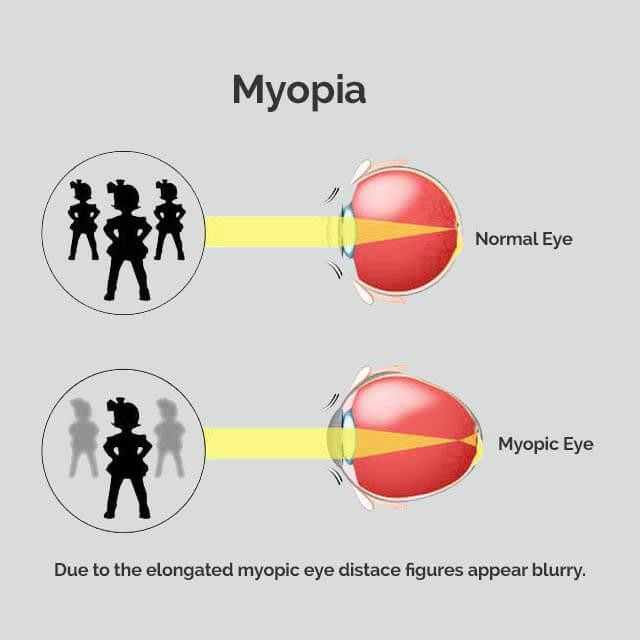News
Blog
MYOPIA PROGRESSION
Myopia is the most common refractive error and it is increasing at an epidemic rate in the world. It is predicted that myopia prevalence will increase to nearly 50% by 2020 affecting 4.8 billion people in the world, which means that one in every two children will become myopic in approximately 30 years from now.
DEFINITION OF MYOPIA:
Myopia occurs if the eyeball is too long or the cornea (the clear front cover of the eye) is too curved. As a result, the light entering the eye isn't focused correctly, and distant objects look blurred.

TERMINOLOGY AND CLASSIFICATION OF MYOPIA:
MYOPIA: A condition in which the spherical equivalent refractive error of an eye is ? ?0.5 D when ocular accommodation is relaxed.
LOW MYOPIA:A condition in which the spherical equivalent refractive error of an eye is ? ?6.00 D when ocular accommodation is relaxed.
MYOPIA:A condition in which the spherical equivalent refractive error of an eye is ? ?0.5 and > ?6.00 D when ocular accommodation is relaxed.
PRE MYOPIA:A refractive state of an eye of ? 0.75 D and > 0.50 D in children where a combination of baseline refraction, age, and other quantifiable risk factors provide a sufficient likelihood of the future development of myopia to merit preventative interventions.
SYMPTOMS:
People with myopia can have difficulty clearly seeing a movie or TV screen, a whiteboard in school or while driving. Generally, myopia first occurs in school-age children. Because the eye continues to grow during childhood, it typically progresses until about age 20.
WHY DO YOU NEED TO CONTROL MYOPIA?
Generally, once you become myopic, it tends to worsen over time. Higher levels of myopia are associated with increased risk of retinal detachment, macular degeneration, foveoschisis, glaucoma, and cataract at earlier age.
Even 1D of myopia doubles the risk of myopic maculopathy and posterior subcapsular cataract, and triples the risk of retinal detachment compared to the emmetrope. At 3D of myopia, the risk of posterior subcapsular cataract triples, with the risk of retinal detachment and myopic maculopathy being nine times that of the emmetrope.
WHAT CAUSES MYOPIA DEVELOPMENT AND PROGRESSION?
Myopia development and progression is determined by genetic factors, individual characteristics and the visual environment.
WHY MYOPIA PROGRESSION HAS TO BE SLOWED?
Every reduced dioptre of myopia, reduces the lifelong risk of myopic maculopathy by 40%.
The key message is if that we can keep myopia below -3.00 and axial length below 26mm this is a huge modifying factor for lifelong risk of visual impairment.

TREATMENT OF MYOPIA:
Eyeglasses: For most people with myopia, eyeglasses are the primary choice for correction.
Contact lenses. For some individuals, contact lenses offer clearer vision and a wider field of view than eyeglasses. However, since contact lenses are worn directly on the eyes, they require proper evaluation and care to safeguard eye health.
Laser procedures. Laser procedures such as LASIK (laser in situ keratomileusis) or PRK (photorefractive keratectomy) are also possible treatment options for myopia in adults.
Other refractive surgery procedures. People who are highly nearsighted or whose corneas are too thin for laser procedures may be able to have their myopia surgically corrected. A doctor may be able to implant small lenses with the desired optical correction in their eyes.
Vision therapy for people with stress-related myopia: Vision therapy is an option for people whose blurred distance vision is caused by a spasm of the muscles that control eye focusing. Various eye exercises can improve poor eye focusing ability and regain clear distance vision.
People with myopia have a variety of options to correct vision problems. Your Doctor will help select the treatment that best meets the visual and lifestyle needs of the patient.
WHICH OPTION TO SLOW MYOPIA?
LOW DOSE ATROPINE: Atropine 0.01% is recommended by AAO and is effective in reducing myopia progression with less rebound effects. It is well tolerated with best therapeutic index.
BIFOCAL OR PROGRESSIVE GLASSES OR MULTIFOCAL SOFT CONTATCT LENS
ORTHOKERATOLOGY LENSES
CHANGING LIFE STYLE:
- Playing outdoors under sunlight.
- Maintaining proper distance while reading and watching TV.
- Avoid continuous near work.
- Limit screen time
Every child, whether an at-risk pre-myope or progressing myope, benefits from this simple visual environment advice.



